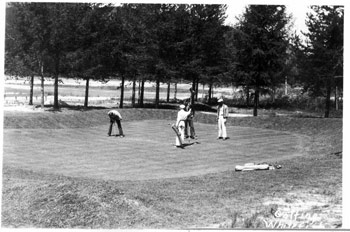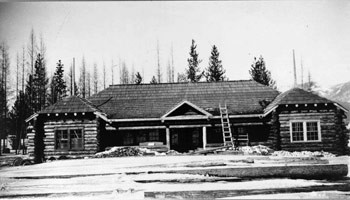WHITEFISH – There are certain iconic images that figure so prominently into a community’s inception they become fixed in its collective memory. In Whitefish, those snapshot tableaus could be arranged on a carousel, tracking the evolution of an industry-turn-resort town.
There is the old Baker brothers’ sawmill, built at the turn of the 20th century on the stump-studded south shore of Whitefish Lake, where a raft of floating timber choked the confluence of the Whitefish River. Then there’s the laying of steel and the Great Northern Railroad’s mighty steam locomotives chugging through Bad Rock Canyon and toward the rugged peaks of Glacier National Park.
There are the early pioneers of Big Mountain ski area, gripping vintage cane poles affixed to leather-bound baskets the size of planetary rings, their long wooden boards chattering underfoot, negotiating steep, snow-covered expanses as their wool-clad frames silhouetted against snow-ghosted firs.
And then there is the sprawling emerald fairway at Whitefish Lake Golf Club, a Stetson-clad linksman teeing off in the foreground while an airplane circles above, the pilot preparing to alight on a course that, during the Depression era, served the dual purpose of an emergency airstrip, while the log clubhouse doubled as the terminal and was dubbed “an administration building for a nine-hole airport,” according to the book “Stump Town to Ski Town: The Story of Whitefish, Montana.”
That final image will be the most relevant at the upcoming 77th Annual Earl Hunt Memorial Fourth of July Tournament, which runs three days and boasts a history that’s as old and rich as the course itself.
“The history and foundation of the Whitefish Lake Golf Club is like a who’s who of Whitefish,” Terry Nelson, the club’s legendary golf coach, said. “The names of the original founding members are the people who, if you read the history, kind of set the tone and culture of Whitefish.”
D.P. Dedon, Lloyd Muldown, George “Doc” Johnson, Rusty and Louise Abell, R.F. Haines, Russ Street, Clark Forcum. They are the names of bankers and grocers, pharmacists, businessmen and physicians. They are also the names of avid skiers and golfers, local folks who played in this tiny community just as hard as they worked to build it.
“My dad was part of a big group of people who started the golf course and the ski hill,” Mike Muldown, son of Lloyd Muldown, the “Father of Big Mountain,” said. “It was a group of forward-thinking people who made Whitefish what it is today. They were a unique bunch. And as a kid it was spectacular. It was Shangri La.”
The initial 104-acre investment in the golf course was spearheaded by Dedon, a grocer, along with several other residents. It cost $1,600, but development of the course plodded along due to a dearth of funds.
In 1934, officials applied for a grant under the Work Projects Administration, a product of President Franklin D. Roosevelt’s New Deal Agency, which appropriated money for public works projects.
Although a golf course and adjacent baseball diamond qualified under the WPA-approved criteria, a proposed emergency landing strip would generate even more federal funds, so trees were cleared across four fairways to allow a plurality of uses.
“There was a slight dog-leg where you teed off at the 16th hole, and that was the runway used by the FAA as an emergency landing strip in the early days,” Mike Dowaliby, the club’s longtime PGA professional and Hall of Fame inductee, who retired in 1999, said.
The property owners donated the land to Flathead County in 1933, and the county transferred the deed, along with the debt, to the City of Whitefish in 1934, the same year the Whitefish Lake Golf Association formed. Members were charged a 25-cent annual membership, but their countless hours of volunteer work were worth far more.
Today, the course is still managed on a not-for-profit or break-even basis, and any money made is invested in the facility.
The Grand Opening Tournament was held in May 1936, and would later evolve into the club’s Fourth of July Tournament, which is now the longest-running and largest amateur tournament in the state. It also boasts some of the best talent, having drawn high-caliber professionals every year since the beginning.
“It’s really our showcase tournament, and I would stack it up talent-wise as one of the best fields of any event in the Pacific Northwest,” Tim Olson, Whitefish Lake Golf Club’s PGA professional of 14 years, said.
 |
|
Photo courtesy Stumptown Historical Society |
“It’s the best field of players in the state,” Nelson agreed. “There are typically 20-plus scratch players or better. That’s just remarkable.”
In 1977, Dowaliby was hired as the PGA Professional at Whitefish Lake Golf Club, beating out professional golfer Jack Fleck for the job. Fleck, the oldest living U.S. Open champion, is best known for his 1955 victory.
“I was lucky to get the job here,” Dowaliby said.
As the head pro it was Dowaliby’s responsibility to organize the three-day Fourth of July Tournament, the logistical smoothness of which has drawn a clutch of touring professionals every year since the inaugural.
He recalls the challenge of making adjustments to the course and the tournament under the watchful – and often critical – gaze of the original members.
“They’re the guys who built that place and it was up to me to make sure that they came around,” Dowaliby said.
Then, as now, there was an influx of Canadian traffic, and some of the local contingent didn’t welcome the tide of outside visitors, whose presence manifested in the parking lot’s checkered mosaic of yellow license plates – the 60s-era plate design of Alberta.
“The old-timers would come up to me and say, ‘what are we going to do about these Canadians?’” Dowaliby said.
Today, relics of that bygone era still characterize the Whitefish Lake Golf Club, and are perhaps most evident at the Fourth of July Tournament.
When Dowaliby retired in 1999, he passed the torch on to Olson, though coach Terry Nelson would help organize the tournament for several years.
Nelson, who has reams of aging agendas and minute entries from the Whitefish Lake Golf Association’s early meetings, recalls finding one particularly terse entry leading up to the tournament.
 |
|
Photo courtesy Stumptown Historical Society |
The minute entry, circa 1940, sets forth a motion that “we lay in enough Scotch whisky to last until October. The motion was seconded.”
“That was the total content of the meeting,” Nelson said.
In 1962, an additional nine holes were added to make Whitefish Lake Golf Club a standard course. As its popularity grew, the course was operating at near capacity and a group of local entrepreneurs bought property south of Highway 93. The Grouse Mountain Development group, headed by Tim Grattan, built another nine holes in the 1980s.
The principals of Grouse Mountain leased the land to the Whitefish Lake Golf Association at a rate of $1 per year for 75 years, with a renewable option for the same terms. In 1994, another nine holes were completed, and in 2003 Grattan donated the property to the Whitefish Lake Golf Association, placing full ownership of the South Course into the association’s hands.
Today the tournament is dedicated to Earl Hunt, a one-legged golf aficionado, former clubhouse bartender and designated course starter, who greeted all participants with a familiar “tee it high and let it fly.”
“It is almost like a family reunion,” Olson said. “There are so many faces who come back year after year.”
The tournament draws a maximum of 220 participants, who will converge on Whitefish July 4-6.
Although Dowaliby is now retired and no longer competes in the tournament, he says the three-day event is a must-see for spectators interested in the history of the club, the course and the community.
“It just rolls on,” Dowaliby said. “It has been so much fun to be a part of.”